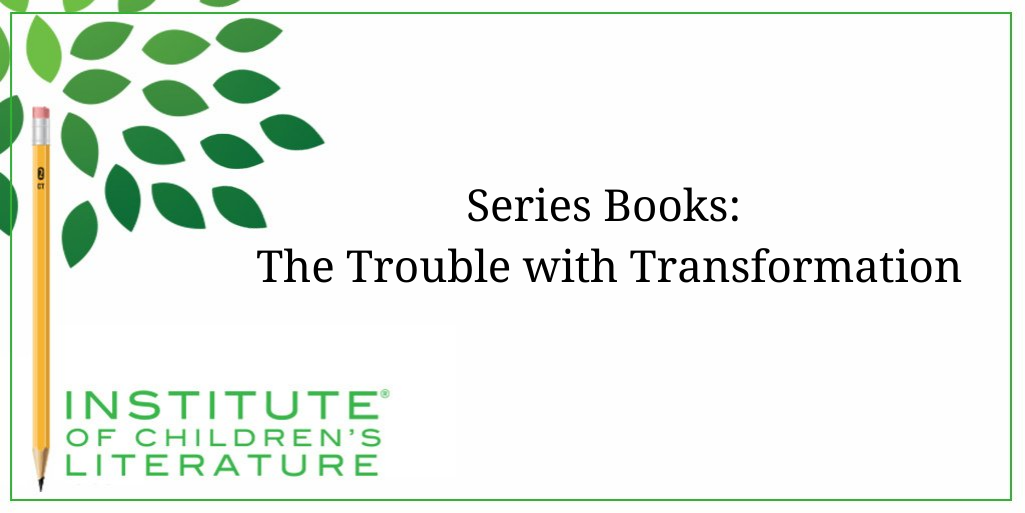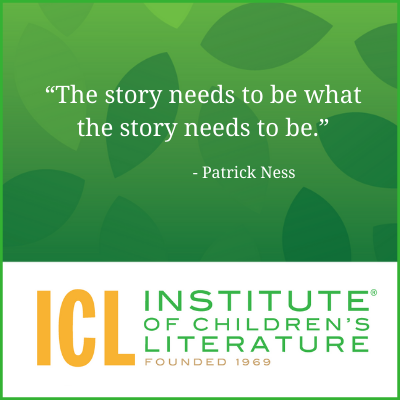
5 Ways Writers Can Prep for 2025 Goal Setting
Before we roll on to the new writing year, let’s harness our optimism for the blank slate before us and prepare for our 2025 Goal Setting just for writers.

We teach our students how to write and get published!
View our Course Catalog >
One of the purposes of plot is transformation. Characters begin in one set of circumstances with one set of problems and needs, and through the action of the plot, they are transformed, ending up in a new situation as new people. In a well-plotted book, characters at the end of the tale are not the same as characters at the beginning. But series books operate by a different set of rules, sometimes a very different set of rules. Your series may allow slow and gradual change in your characters, or it may require characters start each book as nearly identical people. Series books for very young readers often require characters who don’t change, or not much anyway (though they may learn things). So how do we handle character transformation in series books where readers fall in love with characters and expect to meet those same people, sometimes exactly the same people, book after book? What do we do with character transformation? As with many things about series writing, the answer is planning.
Whether your characters undergo transformation and how much transformation they might undergo needs to be something you think about before you begin. If you want, for instance, a series where readers can pick up a book at any part in the series and read it without confusion, then transformation is going to have to be subtle and carefully handled. A character who is horrifically injured in book three, for example, would reasonably carry the result of that experience into every book afterwards, but a reader who jumped from book one to book four would have to be given the information to make that progression smoothly.
All of us have seen television series or even movie series episodes that do this sort of thing, only to return the main character to perfect health in the next episode, even though we know that couldn’t happen. Now, if you have futuristic or fantasy elements (like Star Wars, for instance) a character whose hand is lopped off in a particularly tense moment might be restored and characters never speak of the lopping off again. But that tends to feel like cheating. Would you really walk away from something like that, never to think of it or suffer the results of it again?
So consider your changes to characters carefully. Do you want to carry them from book to book? Do you intend to allow a long period of time between books to enable change to be adapted to between books (this can be difficult with books for kids because you can put a year between books in adult series with far less physical and emotional change than in a children’s novel.) Thinking about and planning for these questions of change will help you execute a series well and with less complications for you as writer.
One way to deal with the problems that come from character transformation is simply to avoid transformation. Unfortunately character discovery and change is essential to a strong book. And keep in mind that series books are usually decided upon by the publisher after the first book is sold, so you definitely don’t want to try to get away with a main character who doesn’t grow and change. Instead, you need to think about change that doesn’t kill the series (or series potential).

So now for book 2, the main character must make the trip and save herself. Thus, the first book would have involved lots of transformation as the main character learns that there is this second world and learns what she herself is capable of when it comes to saving her parents. Now in this second book, she will literally confront herself and see all her strengths and flaws mirrored by this second version of herself. That’s likely to create frustration, conflict, and stress. She’ll have to change the way she sees her own weakness in order to save this second version of herself. So maybe in the second book, she saves herself, and the book ends with her heading off to do what she did to get out of the parallel world the first time.
Now maybe in book three, she goes through the process of leaving, only to find she either can’t leave or that she now ends up in yet another world with whole new problems. Do you see how this kind of “yes, and…” plotting allows us to complete each book with the plot wrapped up and change made, but still leave an open door for the next book in the series. Each new plot will confront the main character in new ways and she will change more. Life is change so there really is no end to how much we can grow through experiences. This is how you plot a progressive series.
With my Misfits Life for Me series for Abdo, I used this kind of progressive plotting. Each book has its own complete adventure plot where the characters (especially the main character) grow and change, but the adventures are also moving the characters on to an ultimate series conclusion. They aren’t a story divided into four parts, they are four complete books that also have an overall arc.
In a strictly episodic series, you’ll see far less progression (though it’s rare that you won’t see any.). Classics like The Magic Schoolbus series and The A-to-Z Mysteries tend not to have any kind of arc to the series. Each book is a single, independent story linked only by the overall story structure and the characters. The A-to-Z mysteries, for example, are always about three friends who stumble upon mysteries. The Magic Schoolbus is always about a wild, impossible field trip led by Miss Frizzle that takes a group of kids into new places and new learning. The old Nancy Drew series tended to have a similar episodic feel. This kind of strictly episodic story is especially useful for series done via work-for-hire as often the publisher is looking for books that can be read out of order.
Thus, the discovery and change in the books will tend to be smaller, though you’ll usually still see it. You may have a story where the kids have had an argument based on a misunderstanding and as the story unfolds, they work through the bad feelings and see the root of the problem was bad communication. They’ve overcome this thing and learned something. Thus, you won’t be able to base future episodes on bad communication, but nothing else about any of the characters is really changed. It’s a used-up plot rather than some kind of root change.
Series books work best when the characters aren’t working through and facing the same problems over and over. In other words, don’t undo what your characters learned. Instead, make character growth and change small enough, and characters complex enough, that you have plenty of different things they can work on, lots of different places where they can change. It’s better not to work on core personality weaknesses as that will cause too much change for strictly episodic books. A character who is shy in book one to the point that he practically cannot talk to strangers at all, but who learns to reach out for the sake of himself and others wouldn’t then go back to square one in book two. A character who is bossy but learns that bossiness can lead to disaster wouldn’t then go back to insisting everything do things his way all over again in book two. Big change that is inherent in the character’s personality cannot be ignored, not even in an episodic series. Not unless you want to upset and frustrate readers.
So growth and change can be tricky in series writing. You don’t want to ignore it or simply omit it. You still want plots that feel real and that linger in the mind of the reader, but you do need to recognize how anything that happens in one book has the potential of effecting future books. That doesn’t mean you don’t throw yourself completely into the book at hand. You write for today, but you think for the future. It’s challenging, but the results are rewarding. Almost every book-loving child or adult can tell you their favorite series, books that let readers fall in love with characters who become true friends through book after book. Being part of that as a writer is wonderful.
With over 100 books in publication, Jan Fields writes both chapter books for children and mystery novels for adults. She’s also known for a variety of experiences teaching writing, from one session SCBWI events to lengthier Highlights Foundation workshops to these blog posts for the Institute of Children’s Literature. As a former ICL instructor, Jan enjoys equipping writers for success in whatever way she can.

Before we roll on to the new writing year, let’s harness our optimism for the blank slate before us and prepare for our 2025 Goal Setting just for writers.

Writers can be thin-skinned when it comes to getting feedback on their work. Let’s look at 4 ways to positively deal with constructive criticism!

Rejection is part of the territory when it comes to being a writer. Today we offer reflection for writers to help redirect your efforts after a rejection.
1000 N. West Street #1200, Wilmington, DE 19801
© 2024 Direct Learning Systems, Inc. All rights reserved.
1000 N. West Street #1200, Wilmington, DE 19801
© 2024 Direct Learning Systems, Inc. All rights reserved.
1000 N. West Street #1200, Wilmington, DE 19801
© 2024 Direct Learning Systems, Inc. All rights reserved.
1000 N. West Street #1200, Wilmington, DE 19801
© 2025 Direct Learning Systems, Inc. All rights reserved.
1000 N. West Street #1200, Wilmington, DE 19801
©2025 Direct Learning Systems, Inc. All rights reserved. Privacy Policy.
2 Comments
Thank you for another great article! In my series, The Ituria Chronicles, the time covered is several hundred years; however, each story is written as a stand alone story. I created a timeline so that I can track the progress of each of the several characters, who are acting independently based on a common premise. As you noted, if the main character of a book needs to know something that happens in another book, they will learn it in the first chapter or two through various sources. Thanks again for the great advice!
Sounds like you’re doing a great job with that, Barbara. A timeline is so useful. Thanks for sharing.